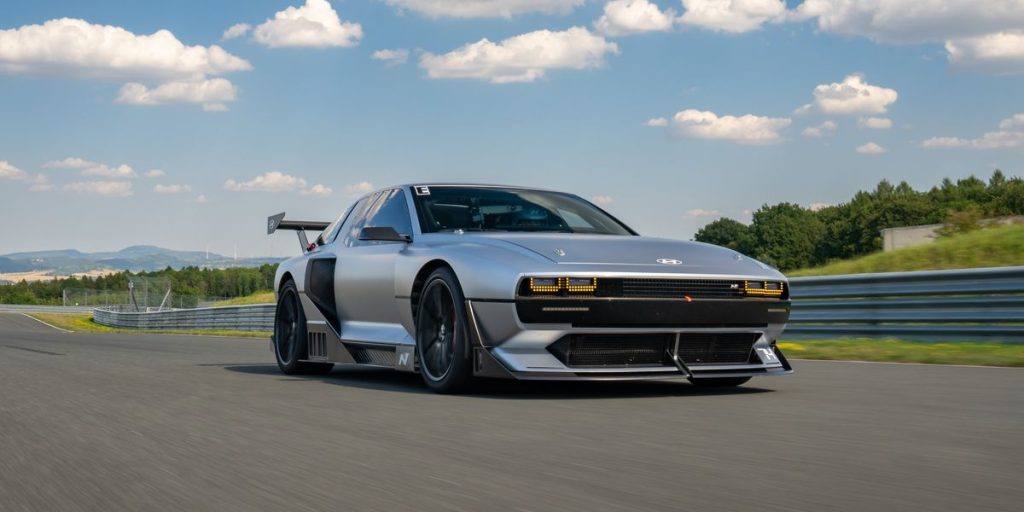Stunning Hyundai N Vision 74 Is a Wild 'Rolling Lab'

Few of us who grew up in the ’80s—or any other decade—would disagree with Dr. Emmett Brown’s introduction of the DeLorean DMC-12 in Back to the Future: “The way I see it, if you’re going to build a time machine into a car, why not do it with some style?”
Now we know that the same principle holds true for future-looking hydrogen fuel-cell demonstrators. Hyundai’s N Vision 74 “rolling lab” doesn’t just bear a passing resemblance to the stance and proportions of the DeLorean, it actually has a genuine, if distant, connection to the stainless-steel sports car.
This hydrogen-fuel-cell/electric hybrid sports-car concept set the automotive internet alight when it was first shown a couple of months ago. The N Vision 74 demonstrated Hyundai’s continued commitment to hydrogen power through the combination of a 670-hp powertrain and what those early images suggested was the ability to generate impressive drift angles. Now we’ve had the chance to drive an engineering prototype, and we can confirm that the N Vision 74 has both superstar presence in the flesh and the ability to smoke its rear tires. This is the sort of future we can all get behind.
Sadly, there are no plans to put the N Vision 74 into production—the drivable version was created mostly to help Hyundai learn more about what the company calls a “virtual differential”—two separate 335-hp motors with no physical connection between them power its rear wheels. Nor, it turns out, is the engineering car actually a Hyundai underneath.
“It’s a [Kia] Stinger,” Albert Biermann tells C/D with a broad grin. The 66-year-old German left BMW’s M Division to become Hyundai-Kia’s R&D boss and also founded Hyundai’s N Division. Although he’s now retired from that job, he still works for the group under the far-ranging job description of executive technical advisor. It’s a role that, clearly, gives him the ability to make PR executives squirm as he heads off the official script. “The design came much later, and the whole idea started off with a different brand, it wasn’t an N thing at all, it was for the luxury brand [Genesis]. But then we said, ‘This is a lot of complicated stuff,’ so we had to build a mecha-proto—which is what we call a prototype built on an existing car—and then apply the new systems. We realized the Stinger was closest in terms of size.”
Four of these Stinger-based prototypes were built, each with the 85-kW fuel-cell stack from the existing Hyundai Nexo in addition to a high-performance 62.4-kWh battery pack. As 85 kilowatts translates into 114 horsepower, those numbers make clear that the hydrogen stack isn’t directly providing the power required by the high-output motors; rather, it is acting as an on-board charger to extend range. Hyundai quotes a figure of about 370 miles from the combination of a fully recharged battery pack and the 9.3 pounds of hydrogen the twin rear tanks can store.
The decision to turn one of the prototypes into the N Vision 74 came later, and the concept’s bodywork involves a deep dive into Hyundai’s earliest history. Lee SangYup, executive vice president of design, led the project. He’s a man with plenty of experience when it comes to styling muscular coupes. Before joining Hyundai, he was responsible for both the 2010 Chevrolet Camaro and the gorgeous Bentley EXP 10 Speed 6 concept from 2015. As its name suggests, the N Vision 74 takes its inspiration from the 1970s, when Hyundai commissioned Giorgetto Giugiaro to create a coupe version of the company’s first independently produced car, the Pony hatchback. The result had much of the wedgy form common to his more famous designs from the same era—but probably the closest resemblance to the Alfa Romeo Alfasud Sprint and the 1970 Porsche Tapiro concept.
The Pony Coupe didn’t make production. The fledgling company had more urgent needs than a halo coupe and, as Lee admits, “We didn’t have an engine or suspension that could match the design.” The project was dropped, but the original tooling blueprints stayed in the company archives—and Giugiaro used them as the starting point for what became the DeLorean DMC-12, albeit with the addition of gullwing doors. And although officially inspired by the Pony Coupe, there is something unarguably DeLorean-ish about the N Vision 74’s profile and the dark fascia bar where the pixel headlamps are located. Lee has one request, though: that we don’t call it the “Seventy-four.” “It sounds much better in Korean: Chilsib Sa,” he says.
We start out in the passenger seat at the Bilster Berg track in northwest Germany, a demanding and heavily graded private driving circuit built on the site of a one-time munitions depot. Having negotiated the roll cage and strapped ourselves into the racing bucket seat, it’s possible to see some of the Stinger that still lurks in the dashboard architecture. We set off, and very quickly it becomes clear that this is not one of those fragile concept cars that must be treated with kid gloves. Project engineer (and amateur racer) Jonghyuk Kwon demonstrates both the 74’s ability to generate uncomfortable g-loadings and substantial drift angles on many of Bilster Berg’s turns.
Our drive is less spectacular. Hyundai’s desire to protect this hugely expensive one-off means that the traction control has been switched back on. The N Vision 74 feels at least as fast as its official claimed number—a sub-four-second 60-mph time, according to Hyundai. Its accelerator response is searingly direct, and, unlike cars that turn their motors directly from a fuel cell, there is no sense of output slackening as the stack struggles to keep up with demand. In the N Vision acceleration feels relentless, and as the speedometer streaks past 88 mph, we’re half expecting to suddenly be transported to 1955.
Sitting on street-spec Pirelli P Zero 4S tires and weighing around two tons, the N Vision struggled a little under braking—the pedal feels wooden, and stopping distances into Bilster Berg’s slower turns were a little longer than expected. But in corners it was impressively willing to change direction and found impressive adhesion, especially when it came to traction in tighter turns. Despite the lack of any physical connection between the rear wheels (and the amount of torque going to each), responses felt identical to those of a car with a conventional differential. And it stayed similarly natural even when, with the traction control in the more permissive Sport setting, we were able to deliberately push the rear tires into gentle, progressive breakaway. The hydrogen powertrain might be the headline grabber, but the invisible cleverness of the demonstrator’s active systems is the most impressive thing about the way it drives.
While Hyundai remains committed to creating hydrogen-powered future models alongside EVs, none of the purchasable ones seem likely to be retro-inspired coupes. “Will the time come for us to bring this to a customer?” Biermann asks, rhetorically. “It is hard for me to see us doing it; at this moment we don’t need such a car.”
A traditional electric version would be easier to create and still be in keeping with the forward-looking ethos, but the N Vision 74’s sleek, low lines wouldn’t work with Hyundai’s Electric Global Modular Platform, which uses an underfloor battery pack. “Sure, we could make a new battery in a different format,” Biermann says. “Anything is possible. But we would need to spend a huge amount to do so.”
There will be plenty of interesting, purchasable cars in Hyundai’s future, including the forthcoming Ioniq 5 N EV, which promises Porsche Taycan-rivaling performance. Sadly, the N Vision 74 doesn’t look set to become one of them.
Specifications
Specifications
Hyundai N Vision 74
Vehicle Type: dual rear-motor, rear-wheel-drive, 2-passenger, 2-door coupe
PRICE
‘Rolling-lab’ prototype, not for sale
POWERTRAIN
Rear Motors: 2 permanent-magnet AC, 335 hp each
Hydrogen Fuel Cell: 114 hp
Combined Power: 670 hp
Combined Torque: 664 lb-ft
Battery Pack: liquid-cooled lithium-ion, 62.4 kWh
Transmissions: direct-drive
DIMENSIONS
Wheelbase: 114.4 in
Length: 195.0 in
Width: 78.5 in
Height: 52.4 in
Curb Weight (C/D est): 4400 lb
PERFORMANCE (C/D EST)
60 mph: 3.5 sec
100 mph: 7.5 sec
1/4-Mile: 11.3 sec
Top Speed: 160 mph
EPA FUEL ECONOMY (C/D EST)
Combined/City/Highway: 60/64/56 MPGe
Range: 370 mi
A car-lover’s community for ultimate access & unrivaled experiences. JOIN NOW

This content is imported from OpenWeb. You may be able to find the same content in another format, or you may be able to find more information, at their web site.






